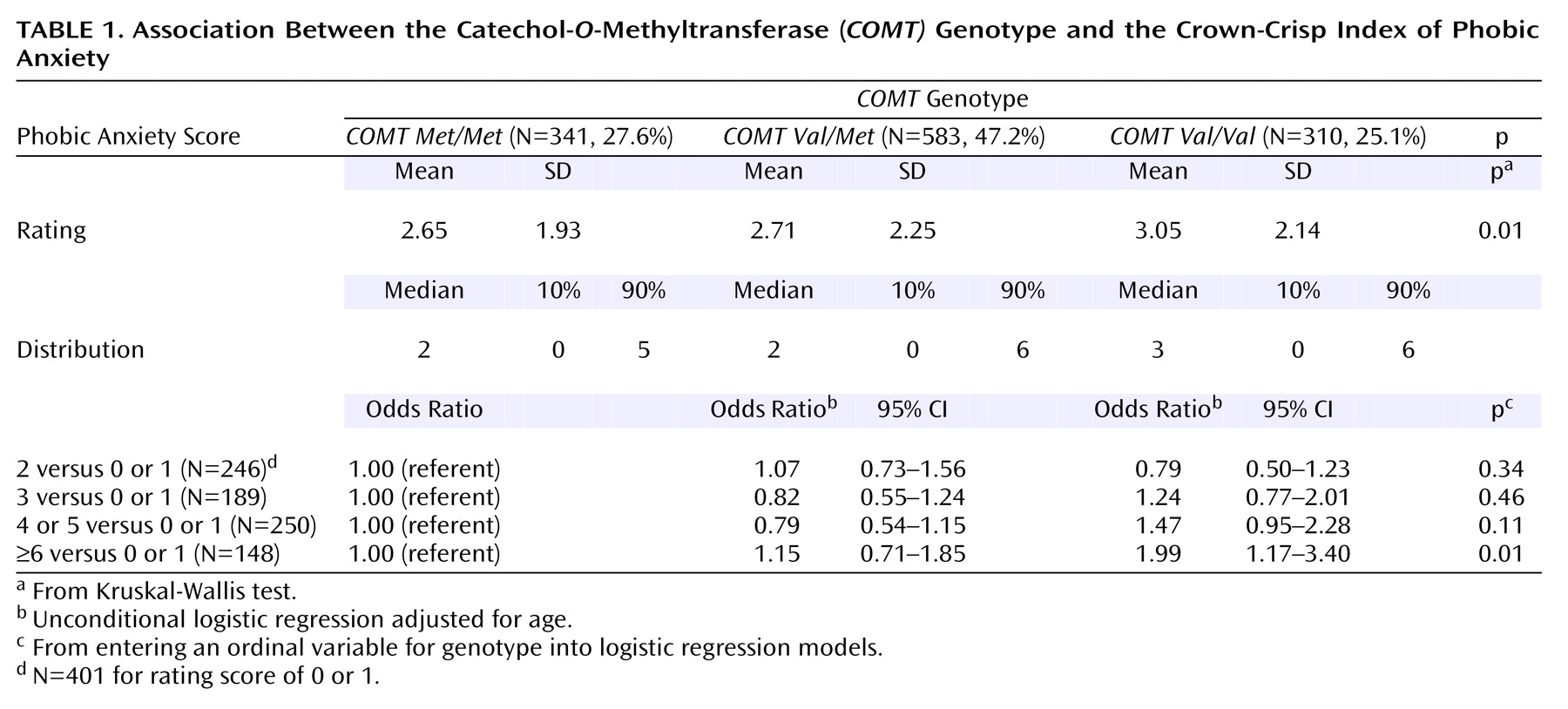Prefrontal dopamine levels are believed to be important in the etiology and expression of anxiety. Catechol-
O-methyltransferase (
COMT) catalyzes the degradation of dopamine
(1). Lachman et al.
(2) identified a functional polymorphism in the
COMT gene leading to a substitution of methionine for valine, encoding for an enzyme with decreased activity. The high-activity
Val allele is hypothesized to impair prefrontal cognition and physiology by increasing prefrontal dopamine catabolism
(3) and therefore would increase the risk of phobic anxiety. Differences in the risk of phobic anxiety may be due to individual differences in catecholamine inactivation by
COMT. We assessed the association between
COMT genotypes and scores on the phobic anxiety scale of the Crown-Crisp Experimental Index
(4) among 1,234 women in the Nurses’ Health Study.
Method
The Nurses’ Health Study began in 1976, when 121,700 U.S. nurses returned an initial questionnaire reporting medical histories and baseline health-related exposures. We used genotyping data available from control subjects from previously conducted studies of breast cancer, endometrial cancer, and Parkinson’s disease to assemble a series of 1,234 subjects who were free of cancer other than nonmelanoma skin cancer. This study was approved by the Human Subjects Committee of Brigham and Women’s Hospital.
The 1988 Nurses’ Health Study questionnaire asked participants to complete the phobic anxiety scale of the Crown-Crisp Experimental Index. The phobic anxiety scale inquired about recent events and consists of eight questions measuring personality traits and symptoms of phobic anxiety, including fear of heights, crowds, and enclosed spaces. Each question has two to three levels of possible responses, with scores on the scale ranging from 0 (no symptoms) to 16 (higher scores indicating higher levels of phobic anxiety). The instrument has been validated in a psychiatric outpatient setting and was found to discriminate patients with anxiety disorders from healthy subjects
(4). Similar to a previous study, we categorized respondents into groups according to total score: 0 or 1 (reference), 2, 3, 4 or 5, and ≥6 (highest level of anxiety)
(5).
Genotyping was performed by restriction fragment length polymorphism assays based on polymerase chain reaction, as previously described
(2). All genotyping was performed by laboratory personnel who were blind to phobic anxiety score. For quality control, a random 10% of the samples was inserted to validate genotyping identification procedures; concordance for blinded samples was 100%.
The chi-square test and Kruskal-Wallis test were used to compare COMT genotypes and distribution of phobic anxiety scores. We used unconditional logistic regression to compute age-adjusted odds ratios and 95% confidence intervals (CIs) to evaluate the association between COMT genotype and phobic anxiety scores. Indicator variables for the COMT genotype were created by using the individual’s homozygote for the Met allele as the referent category. Gene dosage effects were modeled by assigning the values of 0, 1, and 2 to a genotype trend variable, according to the subject’s number of Val alleles. All p values were two-tailed.
Results
The scores on the phobic anxiety index ranged from 0 to 13. Total mean index scores were statistically significantly different for the three genotypes (χ
2=9.05, df=2, p=0.01). One individual item on the phobic anxiety index—“feel panicky in crowds”—was marginally associated with the
COMT genotype (F=2.85, df=2, p=0.06). We categorized women into the following groups: 0 or 1 (32.5% of the population), 2 (19.9%), 3 (15.3%), 4 or 5 (20.3%), and ≥6 (12.0%). There was a marginally significant difference in genotype distribution, according to categorical Crown-Crisp score (χ
2=13.91, df=8, p=0.08). Compared to the
COMT Met/Met genotype, the odds ratios for scoring ≥6 on the Crown-Crisp Experimental Index compared to scoring 0 or 1 were 1.15 (95% CI=0.71–1.85) and 1.99 (95% CI=1.17–3.40) for the
COMT Val/
Met and the
COMT Val/Val genotypes, respectively (
Table 1).
Discussion
Prefrontal cortical dopamine depletion in rats causes an enhanced anxiety level, implicating dopamine in the modulation of anxiety and a necessary component to cope with an anxiogenic event
(6). A recent linkage analysis
(7) provided evidence for a susceptibility locus for panic disorder either within or near the
COMT gene. Given the important role
COMT has in dopamine metabolism, we evaluated the association between
COMT genotypes and phobic anxiety.
Our results suggest that the COMT Val/Val genotype was associated with an increased risk of phobic anxiety (odds ratio=1.99, 95% CI=1.17–3.40). We observed significant differences in phobic anxiety scores among the three genotypes.
Previous epidemiological studies assessing
COMT and anxiety and panic disorder have not been consistent. A Japanese study observed no significant differences in genotype distribution among 108 patients with anxiety compared to 135 comparison subjects
(8). Woo et al.
(9) observed a higher proportion of the
COMT Met allele in 51 Korean patients with panic disorder compared to 45 healthy comparison subjects, and Enoch et al.
(10) observed an association with two harm avoidance subscales and low-voltage alpha ECG and
COMT when comparing the
Met/Met genotype to the combined genotype of
Val/Met and
Met/Met among 75–92 predominantly Caucasian women. The associations observed in these studies may differ from what we observed among our 1,234 Caucasian women potentially because of ethnic differences in genotype distribution, gender, sample size, and differences in outcome assessment.
Panic disorder is twice as frequent in women as in men in the general population
(11). Estrogen has been observed to inhibit
COMT gene transcription
(12), and Gogos et al.
(13) suggested that
COMT has an important sex- and region-specific contribution in the maintenance of catecholamines in the brain. Therefore,
COMT is a candidate gene that can potentially explain the differences in susceptibility and the prevalence of anxiety disorders between men and women. Recent evidence has suggested that the variation at
Val158Met may not be sufficient to identify all genetic variations in
COMT and that the
COMT haplotypes should be used in association studies to ascertain the contribution of
COMT in disease etiology
(14). Further studies stratified by gender are warranted to confirm the association between
COMT and phobic anxiety.


